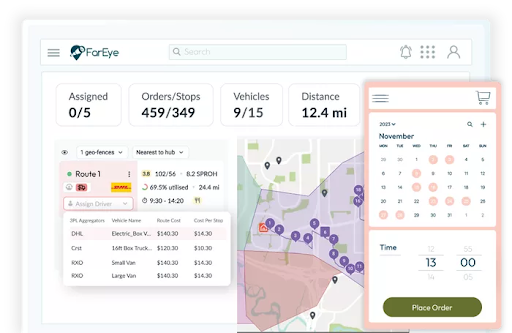- Route Optimization
The Role of Fleet Route Optimization in Improving Driver Retention
Table of Contents
- Why Driver Retention is the Missing Link in Fleet Performance
- How Route Optimization Software Reshapes the Day-to-Day for Drivers and Dispatchers
- Reducing Driver Fatigue, Boosting Satisfaction
- Adapting to Real-World Complexities: From Last-Minute Orders to Skill Mapping
- Turning Data into Driver-Centric Operations
- Scaling Up Without Scaling Stress
- Visibility and Communication: The Human Side of Tech
- Implementation & ROI
- A New Standard for Driver Retention and Fleet Performance
- Every Mile Matters
- FAQs

A summer heatwave hits, and a new refrigerator purchased online by a family is scheduled for next-day delivery. The family has cleared their day, the kids are excited, and every hour counts; food is already on ice in coolers. But as the delivery window comes and goes, the only update is a vague notification: Delayed due to route disruption.
In moments like this, the absence of effective fleet route optimization becomes painfully clear. The driver is nowhere in sight, and customer support has no real-time answer. Dispatchers experience this frustration as well; routes can quickly fall apart due to unexpected order changes, heavy traffic, or delivery stops that exceed the scheduled time.
This experience isn’t unique. According to the American Transportation Research Institute’s report, driver turnover remains near 90% at major carriers, driven by unpredictable schedules and stressful workdays. These disruptions are more than an inconvenience; they directly impact driver satisfaction, customer loyalty, and the bottom line.
The real challenge for today’s logistics leaders isn’t just getting orders from point A to point B; it’s keeping drivers, customers, and dispatchers on the same page.

Why Driver Retention is the Missing Link in Fleet Performance
Logistics teams pour resources into recruiting and onboarding drivers, but many still leave within months. Retention isn’t only about pay or bonuses; it’s about the daily experience behind the wheel. Routes that shift at the last minute, confusing manifests, repeated delays, and a lack of communication can push even seasoned drivers out the door.
A stable, experienced fleet isn’t just a goal; it’s the foundation for sustainable growth. When drivers stay, they know customer preferences, city shortcuts, and the quirks of loading docks that no algorithm can teach overnight. Retaining talent means fewer service failures and lower costs, but above all, it means building trust with both drivers and customers.
How Route Optimization Software Reshapes the Day-to-Day for Drivers and Dispatchers
For a dispatcher, mornings often begin with a scramble of hundreds (or thousands) of orders, last-minute cancellations, special requests, and vehicles spread across a city or state. Manual planning can take hours, and mistakes lead to overworked drivers, missed stops, and unhappy customers.
Fleet management route optimization streamlines this entire process. By leveraging AI and machine learning, delivery route planning software instantly analyzes thousands of variables, traffic, delivery windows, vehicle capacity, service skills, and historical performance to create balanced, efficient routes for every driver.
Instead of fielding frantic calls and reworking plans on the fly, dispatchers gain a central dashboard. This single source of truth allows them to monitor progress, respond to disruptions in real-time, and adjust assignments as needed. The result? Drivers start their day with clarity and confidence, and customer expectations align with operational reality.
Reducing Driver Fatigue, Boosting Satisfaction
Every hour saved in traffic is an hour less of driver stress. When fleet management route optimization considers traffic trends, construction zones, and delivery time windows, drivers avoid unnecessary detours and long waits. The software learns from previous days if a delivery to a certain address always takes 20 minutes, the system adjusts the schedule, ensuring no one is left rushing or stuck in overtime.
Balanced workloads mean drivers aren’t overloaded with difficult or time-consuming routes. With FarEye’s AI-powered routing, automated task allocation ensures fairness, and geocoding reduces errors that send drivers in circles. Predictable days and realistic ETAs help drivers manage their work-life balance, key factors in reducing turnover.
Adapting to Real-World Complexities: From Last-Minute Orders to Skill Mapping
No two delivery days are the same. A driver might receive a call about an urgent medical delivery or need to install a new appliance that requires special expertise. Fleet route optimization software can dynamically reassign orders based on driver location, vehicle type, and even the specific skills required for a task.
For example, if a customer requests an AC installation, the software identifies which drivers are certified for installations, checks their proximity, and adds the stop without disrupting other planned deliveries. This level of intelligent planning, powered by machine learning, prevents delays, avoids customer rescheduling, and keeps operations smooth.
FarEye’s fleet routing solution stands out for its ability to process over 4,000 orders in under eight minutes, factoring in skill mapping, real-time constraints, and last-mile intricacies. This empowers dispatchers and allocators to respond to any challenge with speed and precision.
Turning Data into Driver-Centric Operations
The true power of fleet route optimization software lies in its feedback loop. As routes are executed, the system captures data on service time per stop, driver delays, route deviations, and delivery outcomes. This isn’t just for KPIs; it helps managers spot recurring bottlenecks, identify high-performing drivers, and refine future plans.
With FarEye’s SMART Service Time module, machine learning predicts stop durations based on historical data down to a one-mile hexagon. If a particular customer location always causes delays, the next day’s route automatically compensates. This granular visibility means fewer surprises for drivers, less pressure to make up time, and a fairer basis for performance measurement.
Scaling Up Without Scaling Stress
As businesses grow, so does delivery complexity. It’s tempting to add more vehicles or drivers, but true efficiency comes from smarter planning. Modern fleet route optimization software enables dynamic territory management, co-mingled load planning, and automated SLA prioritization, all while minimizing empty miles and fuel costs.
FarEye’s platform supports hybrid fleets, whether in-house, third-party, or gig drivers, and adapts routes to accommodate electric vehicles, factoring in charging needs and green delivery windows. This flexibility supports sustainability initiatives and future-proofs fleet operations.
Visibility and Communication: The Human Side of Tech
Efficiency isn’t just algorithms and dashboards; it’s about people. With real-time tracking and proactive communication, drivers and customers stay in sync. If a route changes or a delivery window shifts, instant notifications keep everyone informed. Fewer “Where’s my order?” calls, less waiting at docks, and happier customers, all of which circle back to higher driver morale.
Regular driver feedback sessions supported by transparent route data allow drivers to share insights from the road. Incorporating this knowledge leads to even better route plans, fosters a culture of trust, and demonstrates that drivers are valued team members, not just numbers on a spreadsheet.
Implementation & ROI
Typical pilot to regional rollout: 4–8 weeks.
Expected outcomes:
- 5–12% reduction in driver overtime
- 8–15% improvement in first-attempt delivery
- Measurable retention gains within 60–90 days
A New Standard for Driver Retention and Fleet Performance
Driver turnover isn’t inevitable. By focusing on daily experience, balancing workloads, reducing stress, and respecting driver expertise, enterprises can shift the narrative from “just get it there” to “deliver with care.” The right technology partner turns this ambition into an operational reality.
AI-based fleet route optimization, real-time adjustments, and machine learning-driven insights aren’t just buzzwords; they’re the foundation for loyal, high-performing driver teams and delighted customers.
Every Mile Matters
Fleet leaders no longer have to choose between efficiency and driver retention. When route planning starts with the driver in mind and leverages advanced tools, every mile becomes an opportunity, not a challenge. In an industry where talent and time are both scarce, transforming routing from a daily headache into a strategic advantage is not just possible; it’s essential.
Ready to reduce churn and improve driver satisfaction? Request a demo to see how FarEye’s fleet route optimization software balances routes and boosts retention.
FAQs
- How does fleet route optimization reduce driver turnover?
By delivering predictable routes, fair task allocation, realistic ETAs, and better communication, reducing stress and overtime that commonly cause churn. - How quickly will drivers notice improvements?
Many fleets report noticeable improvements in daily predictability and morale within the first 30–60 days of a phased rollout.
Source:

Komal Puri is a seasoned professional in the logistics and supply chain industry. As the AVP of Marketing and a subject matter expert at FarEye, she has been instrumental in shaping the industry narrative for the past decade. Her expertise and insights have earned her numerous awards and recognition. Komal’s writings reflect her deep understanding of the industry, offering valuable insights and thought leadership.
Let's Talk to Our Experts and Optimize Your Deliveries Today!
An expert from our team will reach out within 24 hours
Related resources


